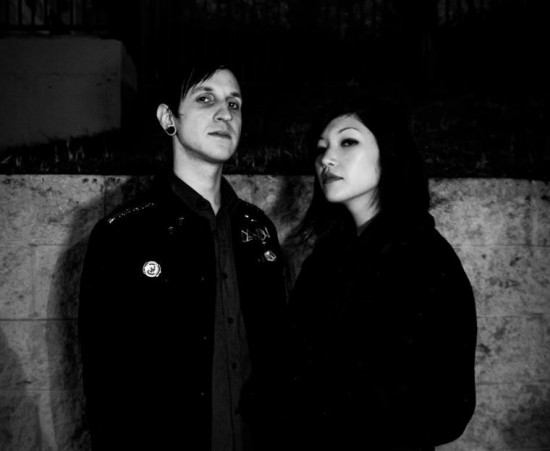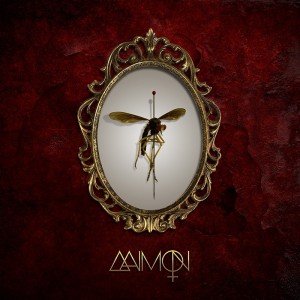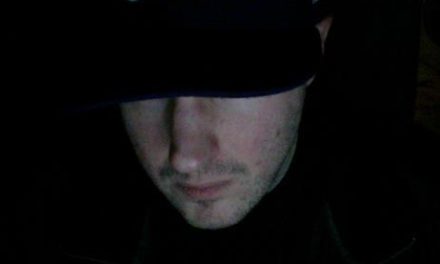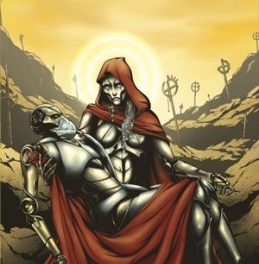Photograph is our feature wherein we ask an artist to reflect upon an album they’ve just released, including the ideas behind songs, the concept behind the record and any other incidental thoughts they might have had. This time we’re checking in with the band whose 2012 EP Flatliner was our release of the year; the mysterious husband and wife team Nancy and Brant Showers, better known as ∆AIMON. Their debut full length is simultaneously unknowable and incredibly familiar, the result of how developed and natural their aesthetic has become. Minus the trappings of the trad witch house movement and stepping further into the realms of deeply composed darkness and pulsing electronics ∆AIMON are the vanguard of the new dark music movement. As long time fans and advocates of their music, we asked Brant and Nancy to tell us about the concepts behind and execution of the new record, and their answers proved… illuminating.
ID:UD: Your first two releases were EPs, and each feels rather distinct from the other in both sound and thematics. Did the structure of an LP affect the writing process?
Brant: The idea of writing a cohesive album with a specific flow to it was very important during the writing process and definitely influenced the direction a lot of the songs took in order to fill gaps in the over-arching aesthetic we wanted to explore with this release. Truthfully though, we try to treat EPs and LPs similarly in that regard. There’s been great examples of EPs that feel like they run a complete course of emotions to a satisfying conclusion (Nine Inch Nail’s Broken and Brainiac’s Electro-Shock For President being my go-to examples of perfectly executed concise story-arcs). Amen and FLATLINER both attempt to follow a similar process, they probably just differ thematically because of how specifically each represents where and who we were at the moment of their production. The full-length format certainly allowed us to delve deeper though and we absolutely tried to make use of that.
Nancy: I think the songs on the LP are generally more structured than some of our previous tracks, though like Brant said, we have always tried to create EPs that are substantial, basically mini-albums. One notable difference on the LP is that there are no instrumental tracks. I think we both felt that vocals were an important part of telling a story on this album.
“I think the anxious and chaotic tones of the album are reflective of our lives during the time we recorded it.”
ID:UD: Did you feel you were going into this record with a different mindset than on Amen or Flatliner?
Nancy: Yes. I think the anxious and chaotic tones of the album are reflective of our lives during the time we recorded it. Flatliner had a more romantic, ethereal feel, and it may well have been because we recorded it in the months leading up to our wedding. This year, our schedules have constantly been full, and I feel like we have been playing catch-up in all aspects of our lives. Which isn’t necessarily a bad thing, but I think the frenzy made itself obvious in our music.
Brant: I’d add that the live shows we’ve played since then have definitely changed our perspective as well. Especially in regards to the type of interaction and more personal energy exchange we want with our audience.
ID:UD: Flatliner was released by two different labels – Tundra Dubs and Artoffact – each with roots in related but still pretty distinct musical scenes. Has your understanding of where ∆AIMON sits in terms of who the project appeals to or the traditions it’s touching upon changed in the past year?
Brant: That’s a tough one to answer. I honestly don’t know if we have a stronger understanding now of what fan-base we fit into. If anything we’re just more confident of our particular sound and the interest in conveying our own style. Our fans have been amazingly loyal, for which we’re extremely grateful. It definitely allows us to continue to do what feels natural to us without the consideration of genre limitations. A lot of the acclaim FLATLINER received was from the perspective of it being a new sound infused into the industrial crowd. With the album, we’re expanding on an established style now so it’s hard to tell if the same enthusiasm is there. Hopefully the quality and amount of work put into the songs will be enough to generate the same interest that FLATLINER had.
Nancy: We were really surprised at the support shown by the industrial scene. While industrial is probably our main influence (and perhaps that has become more and more apparent in our music), I don’t think either of us expected to be talked about in the scene or played in clubs as much as we have been. Artoffact has definitely been responsible for getting our name out to people in the industrial circuit who wouldn’t have heard it otherwise. Tundra Dubs was great because it allowed us to connect with other people who had DIY art and experimental projects, which was definitely how we would have classified ∆AIMON when we started out. We feel lucky to have met and made friends with people through both labels.
ID:UD: One of the most definitive characteristics of ∆AIMON’s music (and one we’ve discussed in the past) is how your relationship and the energy that passes between you shapes the sound of the project. With the album being created during the first year of your marriage, did you find that the creative flow had changed between you? Does the personal nature of the album flow from you both in tandem, or are there things that apply more for one of you than another?
Nancy: Though the themes in our music have possibly changed as our relationship has evolved, I’m not sure the creative flow has. I think we are both inspired often and unpredictably to write songs, but since Brant is a natural songwriter, he is able to translate his ideas into songs more easily and quickly than I am. It’s more common for me to start with lyrics rather than a melody. After either of us comes up with an idea for a new song, we both work together to create the appropriate aura for each song, and discuss which sounds will get the feeling across.
Brant: Exactly what Nancy said. We’ve been in a relationship for ten years now and are the type of individuals who are comfortable voicing any criticism or suggestions, so the writing process has always worked well for us. Basically neither one of us is completely satisfied until we both are. Content-wise I do feel there’s a little more of any obvious tone of concern for each other. “Anima” is a good example of a song that I wrote directly to Nancy as a promise. There’s similar sentiments and personal interactions throughout the album between both of us.
“vargtimmen”
Named after the incredible 1968 film by Ingmar Bergman (which was a huge influence on the tone we sought for the album as a whole), “vargtimmen” began as a test piece done to explore the darker themes we hoped to convey throughout the LP. In the period between the release of FLATLINER and the recording of this track, I’d reacquainted with my love of experimental noise music which definitely inspired us to approach the evoking of anxiety and tension through harsher, more immediate seeming production styles.
Nancy’s vocals really solidified the surreal, somnambulism I felt the track carried; another parallel to the Bergman film and a perfect intro piece for bringing listeners into our world.
“Seraphim”
We actually wrote the initial version of “Seraphim” immediately after the FLATLINER sessions but were not happy enough with it to give it a release. It had a lot of potential for the album but definitely required an extensive amount of work before we were both happy with it. The track mostly came about through our experience performing live. The more shows we played the more acutely aware we became of working within a certain energy level that was engaging to our audience. “Seraphim” is a piece aimed at carrying that energy to the record. The subject matter and “attitude” of the track felt like a natural progression from FLATLINER but maybe stands out in context with the full album. This was a pretty large deciding factor for why we chose to release it as the first single (as well as how well it allowed itself to be reconstructed by the remix artists who contributed their variations).
“dissolvte”
This particular track was one we struggled with a bit. Until Nancy’s delivery of the main vocal lines, we didn’t really know what direction to go with and so the track subsequently drifted unfinished for awhile. We came back to it after most of the remainder of the album was complete and now wrote the vocals within the context of the album as a whole. A lot of the time we record vocals last since we prefer to feel the weight of the music and rely on the emotional response it evokes before putting voice to tape. “Dissolvte” is a perfect example, though, of how a song can sometimes rely entirely on the vocals for bringing out those emotions. Nancy nailed the vocals immediately and completely renewed our enthusiasm for the track. We reworked the structure itself and ended up extending the end just because we wanted to hear it longer. It’s honestly one of our favorites now, partly because of the huge change it went through from a meandering sketch into a total jam.
“LOW”
This track originally appeared on the split compilation Robot Elephant Records vs. Tundra Dubs released in March of 2012 through Robot Elephant Records. The compilation featured a great selection of artists from both labels and was a very cool project to be a part of, but ultimately didn’t get as much exposure as it really deserves. “LOW” was getting a great reaction in our live set so we decided to rework it for the album. We used this opportunity to add another verse to the structure and experiment more with the quiet to loud dynamics that were more prevalent in how we performed it live. Hearing it now with the rest of the album, it definitely adds a level of tension appropriate for this release.
“Balance”
Balance is a song that wears its influences pretty heavily on its sleeve. Over-all it definitely has an “album track” quality to it that was important for us to include. It’s one of those songs that people will either skip over or will absolutely identify with. Hopefully the latter. Of all the tracks, this one focuses the most on the qualities we find defines the ∆AIMON project most accurately. All the ritualism and occult traditions we employ revolve around the core concept of individuation of light and dark aspects of our personalities. Nancy and I consistently work towards not only a judicial balance but a literal temperance of what makes us a complete image of our selves – our shadows are still intrinsically us and are an important aspect necessary of being recognized and understood. There’s also a sincere beauty in sadness. I’m not sure of the proper way of expressing what I mean but there’s a well known phrase I return to, sunt lacrimae rerum – from the Aeneid. Again, the definition is elusive to put to proper words but essentially reflects on the suffering that defines our experience as compassionate beings; the burden of humanity is to suffer, not unduly but because our hearts are touched. I think this expression is an appropriate summation of the nostalgia and sadness that pervades our works. Even without proper words to express, it is an emotion many simply know if they have ever woken up from a beautiful dream to find they’ve been crying in their sleep.
“anima”
“Anima” was the second track we tackled for the album and immediately set the bar exceptionally high for how personal and honest the subject matter would be. Sincerity has always been important for us to express but it is still a challenge for us to be so open and revealing at times. I’m happy we committed to it though and followed through because I honestly feel the sentiment of the album is just as significant as the songs themselves.
“amen”
The original of this, as it appears on the Amen EP, was the first song Nancy and I ever wrote together. It just felt like an important gesture for us to include it on our first full-length. However it’s also one of our most recognizable and popular tracks so we definitely wanted to retain the qualities that make it what it is. With that in mind, we mixed it appropriately for the album with new vocal takes and a few altered synth sounds. It’s a new context that gives it a slightly different feel but still has the same intended conviction.
“bruising”
This is another song like “anima” that took on a stronger emotional context than we initially planned. In this case the music and composition completely took over and wrote the lyrics for us. There was no way for us to disagree with what the song dictated. The production on this one was also a bit different for us, especially the way the vocals blur and distort into the synths. It was maybe a questionable decision but we ended up using it for the sake of the earnestness it evinces. I feel it adds the perfect haziness needed to really pull out the aesthetics of the song.
“EXU REI”
A complete reworking of one of our favorite tracks from the Amen EP, this was an easy one to integrate into the album production style. Once we arranged it for new instrumentation and new vocal takes, the track pretty much fell into place on its own. There’s also quite a lot of experimentation with samples and post-processing but something about this track just lent itself especially well to the updated sounds. We debated whether or not to include any of our older works on the album, with how this particular one fits I’m very happy we decided to re-explore what this song had to offer.
“Paræsthesia”
Not much to say other than this is our blatant tribute to trip-hop. We have toyed a little with the genre in the past such as on the song Emptiness from the FLATLINER EP but this is the most unabashed excursion into the style we’ve taken so far. Both of us share a strong interest in exploring it more, so expect a heavier trip-hop influence in upcoming releases.
“Order ∴ ∴:”
We set out to specifically have this track as the most lush piece on the record. In general the album’s compositions have a lot more space than we usually allow. After having done excessively layered songs in the past we made a conscious decision to give these ones some air to breathe. “Order ∴ ∴” and “APOSTATIC” on the other hand both build to pretty frantic levels. Our music tends to enjoy a bit of sexual tension and danger within the smoky and feverish anxiety of it all. “Order ∴ ∴” is the culmination of this tension finally breaking. As in, finger quotes, “breaking.”
“APOSTATIC”
This was the last song we finished, mostly due to it requiring some major re-writes. It being the last song recorded as well as the last on the album track-list worked in our favor though since we had the necessary context to make it the appropriate resolution piece the album required. The somewhat gospel sounding vocals came about almost through accident. As we were experimenting with several melody ranges it eventually made more sense to layer all of them. The result was exactly what the track needed to finalize the album. We wanted to end it on a pretty strong note and feel this song does exactly that.
∆AIMON is available on vinyl, CD, and cassette, as well as digitally on iTunes and on Bandcamp.









Thanks so much for giving us the opportunity to do this. It’s our first time attempting to deconstruct our writing process and delve into track by track concepts, so if we inspired more questions we’d happily address them.